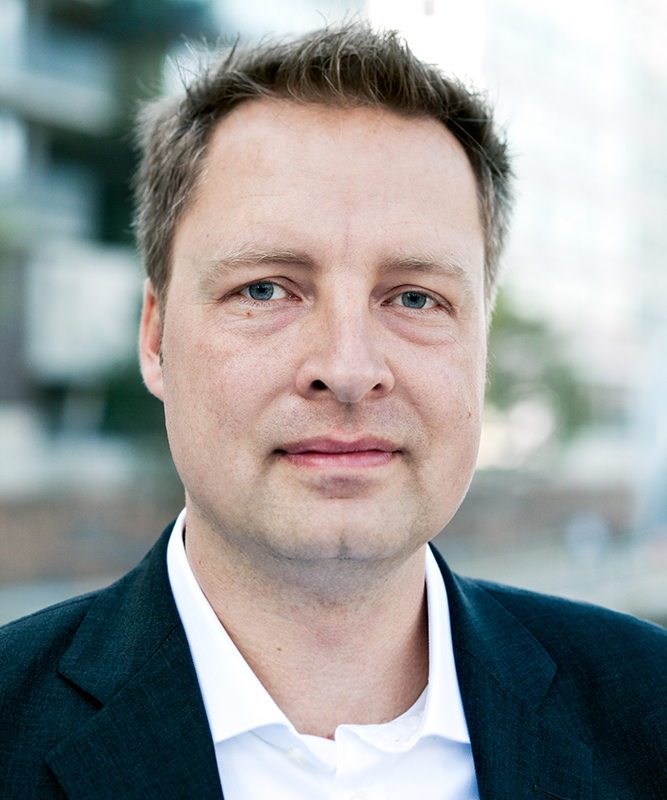Red and green zones make isolation ward safer Dr. Wolfgang Sunder from the Institute of Construction Design, Industrial and Health Care Building on infection prevention through architecture
The Corona pandemic has made it clear: In addition to early containment, more focus must be placed on the prevention of infections worldwide. While much has already been done on the part of medicine and biology to prevent the transmission of pathogens, it is only in recent years that architecture has come into focus as another important discipline of infection prevention. Here, the Institute of Construction Design, Industrial and Health Care Building (IKE) at Technische Universität Braunschweig is also attracting international attention with its research. Dr Wolfgang Sunder reports on how clever spatial planning can help prevent infections and on the special challenges the IKE team is confronted with in projects in Rwanda.

When planning a special isolation ward, different areas should be strictly demarcated from each other. Picture credits: Gerd Altmann/Pixabay
Mr Sunder, the Corona pandemic has given the topic of infection prevention a special significance. The Institute of Construction Design, Industrial and Health Care Building (IKE) has already dealt with this before. How did this orientation in the field of healthcare construction come about?
In Germany, about half a million hospital infections occur every year. The number of deaths caused by so-called nosocomial infections is between 6,000 and 15,000 per year. These are infections that occur after the patient has been admitted to hospital. In addition, the proportion of patients with infections caused by multi-resistant pathogens has increased. Multi-resistance means that many antibiotics are no longer effective.
At the IKE, we have been concentrating on the topic of infection prevention for the past ten years, as we are convinced that structural measures for infection prevention currently play and will continue to play a relevant role in the future. In a series of studies, we have already been able to prove that we can decisively minimise the contact transmission of pathogens with architectural solutions. In addition, our studies show how great the evidence is for such architectural intervention measures. An interdisciplinary research team with experts from the fields of architecture, process planning and hygiene is working on various aspects of structural infection prevention at the Institute.
And what prompted you to deal with the topic yourself?
An important trigger was the research project “Praxis: Krankenhausbau: Handbuch zur interdisziplinären Planung und Realisierung von zukunftsfähigen Krankenhäusern” (Practice: Hospital Construction: Handbook for the Interdisciplinary Planning and Realisation of Sustainable Hospitals) of the federal research initiative “Zukunft Bau” (Future Construction), which was completed in 2014. As part of this work, we conducted a large-scale survey among planners, operators and users of hospitals with a total of over 800 participants. Infection prevention in buildings was identified as one of the most important characteristics of an efficient health care building and addressing this challenge was rated as insufficiently researched so far. These findings prompted me and my colleague Jan Holzhausen to initiate and successfully implement the research project “Bauliche Hygiene im Krankenhausbau” (Structural Hygiene in Hospital Construction) together with hygienists, material scientists and hospital operators.
How can architecture protect against infections?
The risk of infections can be reduced through structural framework conditions that enable an uncomplicated workflow and structurally generated positive incentives, also called “nudging”, for example when it comes to hand disinfection. In healthcare, an environment in which patients feel comfortable and medical staff are exposed to few additional stress factors can have a protective effect. Accommodation in single rooms with and without airlocks reduces the risk of infection – especially in intensive care units. In this way, contact transmission between patients is greatly reduced. The separate room can also be an additional factor in being a reminder for disinfecting hands consistently. These are just a few examples.
However, the development of effective infection control concepts can only happen through the cooperation of experts across disciplinary boundaries, in line with the One Health approach. Infection prevention in buildings is a relevant factor here. However, a cost-benefit comparison is still needed that examines the economic effects of the structural measures.
With the project “EFFO – CoE”, IKE is involved in Rwanda for the second time. You and your team already completed isolation wards in the country in 2019. What are the special challenges here? Why did you choose Rwanda?
In the context of the world’s second largest documented Ebola outbreak in the Democratic Republic of Congo, cases were also recorded in neighbouring Uganda and Rwanda in 2019. Strengthening infection control in health facilities was imperative with the threat of Ebola fever cases in Rwanda. In the emergency aid project “EFFO-HCF”, funded by the Federal Ministry of Health, the IKE team created two isolation units for the temporary treatment of patients in close coordination with the project partners from Germany, the Robert Koch Institute (RKI) and the Institute for Tropical Medicine and International Health at the Charité Berlin, as well as the Rwandan cooperation partner Rwanda Biomedical Center (RBC). The major challenge in the project, apart from all the cultural aspects, was above all the consideration of diseases caused by highly pathogenic pathogens (high consequence infectious diseases, HCID).
The Robert Koch Institute has had an ongoing cooperation with the state of Rwanda for several years. In the programme EFFO – “Effizienz durch Fortbildung” (Efficiency through Training), local trainers are instructed in dealing with patients infected with Ebola fever or suspected cases. Our close cooperation with the Robert Koch Institute in other projects led to the integration of our construction expertise in the EFFO programme.
African countries already have many years of experience in infection control due to Ebola epidemics. What can we learn from them?
Epidemics are unfortunately not uncommon on the African continent. Since 1976, for example, 22 Ebola outbreaks have claimed over 14,000 lives. The Democratic Republic of Congo was particularly affected, with more than 2,000 people dying in the aforementioned major outbreak in 2019. For two years, attempts were made to defeat the virus here – with success: the outbreak of Ebola in the north-east of the country was officially declared over in June 2020.
The fight against the Ebola epidemic was an important lesson in epidemic management for many African countries. Measures to contain the novel coronavirus were therefore taken faster in some cases than in countries of the Global North.
What we can learn from our African partners is how to contain the disease at an early stage so as not to overburden health systems. Education and training programmes play a major role in this. Many people in Africa were confused by misinformation during the Ebola epidemic. Only education by trusted people such as teachers, pastors or authority figures in the communities helped many people to understand the disease and to take important measures.
The special isolation ward will mainly treat so-called HCID cases, i.e. people infected with high consequence infectious diseases (HCID). What needs to be considered in planning and design?
When planning a special isolation ward, the development of strict area management must be taken into account. The demarcation of (sub)areas with a high risk of infection to (sub)areas with a low risk of infection is the primary goal. The areas mentioned first are marked with the colour red and the areas mentioned last with the colour green. This categorisation helps staff to carry out medical and nursing processes in a hygienically safe manner. In addition, patients and visitors can find their way around better.
Another focus is on avoiding crossroads between the different users of an isolation ward, including staff, patients, visitors and technicians, and the flow of materials such as food, medication, waste and laundry. In this way, hygienically safe structural solutions can be found even without the installation of planning- and maintenance-intensive technical systems. We also have to consider concepts for patient transport, material and waste management as well as the safe handling of deceased persons in the floor plan layout.
Can the findings from your research on the patient room, the demonstrator of which is currently being built in Braunschweig, also be transferred to the special isolation ward in Rwanda?
The central question in planning a patient room in the KARMIN project as well as the special isolation ward in Rwanda is: Which constructional and procedural measures can prevent infections in hospitals? In the KARMIN project, we were able to show how clever room planning and the redesign of hygiene-relevant objects can prevent the transmission of dangerous germs in two-bed rooms. A number of aspects can be transferred to the special isolation ward in Rwanda, for example the zoning and the furnishings.
The KARMIN patient room is characterised by a clear zoning of an entrance area and a façade-side visitor area, as well as symmetrically arranged wet rooms on the left and right sides, the nursing work area and the patient area. This makes it possible to clearly coordinate movement sequences in the room and maintain distances.
In the furnishings, all free-standing objects that touch the floor are mobile and can be easily moved for cleaning. The permanently installed cabinets are built flush so that there are no gaps that are difficult to clean. Each patient is assigned a patient table, chair and cupboard in their own half of the room. This allows the patients to keep their distance and not accidentally touch each other’s objects.
What topics in health building research would you like to tackle next with your team?
We are pleased to announce that this summer we will be able to put the “Patientenzimmer der Zukunft” (Patient Room of the Future) research and study laboratory into operation together with the Fraunhofer Institute for Surface Engineering and Thin Films (IST) Braunschweig, the Braunschweig Municipal Hospital and a large number of industrial partners. The demonstrator will be set up in an open area of the hospital at the Naumburgstraße site. Together with experts from the fields of architecture, medicine, hygiene and materials, we will develop practical model solutions for hospital architecture over the next few years. This includes materials, surfaces and equipment elements that are easy to clean and thus help to contain dangerous germs. In this context, sensors and new innovative cleaning systems that quickly identify and automatically remove germ contamination will also be tested.
In addition, this year we are starting to build a national knowledge platform for infection-preventive construction. The platform, which is accessible free of charge, will sift through fundamental knowledge of infection prevention in buildings with regard to airborne and contact infections in close exchange with the fields of construction, materials, building services and hygiene and make it available to planners and users as recommendations in a comprehensible and practical manner.
Together with partners from the Charité Berlin, the TU Berlin and the Robert Koch Institute, we are bringing together the knowledge from past and current projects, visualising it and also partially transferring it into simulations. It is planned that the knowledge platform can be accessed interactively via the website “Zukunft Bau” of the Federal Ministry for Housing, Urban Development and Building.

